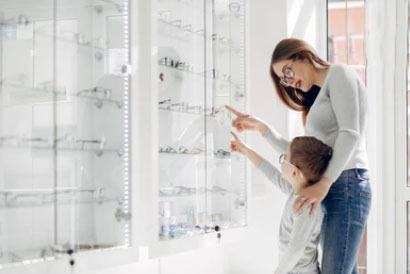Reading Glasses vs Bifocals Glasses

Do you have trouble focusing on print in books, magazines, and more? If so, it may be time to consider glasses. However, do you know what option is right for you? Should you opt for basic reading glasses or talk to your eye doctor about bifocal glasses? This is a good question. Learn more about these options here to find the one that best suits your needs.
Reading Glasses vs Bifocals Infographic
Reading Glasses
Modern reading glasses are available in two basic options. You can purchase them over the counter or choose prescription versions. While the source may be different, the goal of the eyewear is the same; to help you read something closer on a computer screen or in a book clearly.
If your eyes require the same lens strength and if you don’t have an Astigmatism, then using over-the-counter reading glasses may be an effective option. You can purchase these at department stores, drugstores, and other retailers without having a prescription.
With these reading glasses, you have a short-term option. The most common lens power options you can purchase include +1 to +4. You should only use these if your long-distance vision is adequate. Otherwise, prescription glasses may be needed.
Prescription Reading Glasses
If you are dealing with double vision or eye strain, choosing prescription reading glasses may be the best option. These are used by people who are dealing with more serious eye conditions, such as unequal strength lenses, astigmatism, myopia, and more.
Before wearing reading glasses, it is a good idea to consult with an eye care specialist. This is true even if you choose the over-the-counter glasses mentioned above. It is a good idea to have an eye exam in some situations to find out if there are any issues, such as cataracts, glaucoma, or macular degeneration.
Usually, you can choose a range of lower-powered reading glasses, such as +1.25 up to +1.5. If you need to read things that are closer up, then choosing stronger prescription glasses is best—these range from +2.0 up to +2.5. As you get older, the power of the lenses you need will increase.
Selecting Bi-Focal Glasses
Symptoms of presbyopia are typically seen after the age of 40. At this point, you may begin to realize you can’t hold reading material far enough away from your face to see it clearly. At this point, it is best to consult an eye specialist about bifocal reading glasses.
If you are dealing with presbyopia, you will likely choose line-free progressive lenses. Traditional bifocal glasses and trifocal glasses offer some benefits over progressive lenses. Put simply, bifocal and trifocal lenses offer a larger lens area for computer work and reading than progressive lenses.
Bi-Focal Multifocal Progressive Lenses
Several types of purpose-oriented bifocal and trifocal lens design options include eyewear for using computers and other activities that require clear vision. With multifocal lenses, you have two or more lens powers that help you focus on objects located at different distances that your eyes may no longer be able to do because you are getting older.
Progressive multifocal lenses include different lens powers. Usually, multifocal lenses are recommended for individuals over the age of 40; however, in some situations, bifocals can be used for kids or younger adults who have various eye disorders, such as eye strain or focusing.
According to some research, wearing bifocals or other types of multifocal lenses will help children overcome cases of myopia by reducing the strain and work they have to put into reading and close-up work. Virtually all bifocals available today work the same way. A small portion of the glasses is used for close-up vision, while the other works to see far away.
The part of the lens that is used to correct close-up vision can come in multiple shapes. For example, it may be around a segment or a narrow rectangular area. This is called a ribbon segment. Other people opt for the full bottom half bifocal lenses. These are called the Executive style (E style) or Franklin.
It is important to note that glasses will do more than just improve your vision. They provide an extension of your personality, too. Because of this, it is important to find a unique style and look that suits what you like and want to portray.
Adjustment Period
Once you begin wearing bifocal or multifocal lenses, you will have an adjustment period to get used to wearing them. Some people require up to two weeks to fully adjust to the blended corrective powers of the bifocal glassesor multifocal glasses. If you continue to have issues after two weeks have passed and you have been wearing them consistently, it is a good idea to schedule an appointment with your optician or eye doctor. They can make sure that the fit is right for your needs.
FAQs
Are Reading Glasses Better than Bifocal Lenses?
If you currently wear reading glasses, you should consult with your eye doctor to see if multifocal glasses would be beneficial. Bifocal lenses are only better if you need them.
Are Reading Glasses a Good Option?
Reading glasses are helpful for those with presbyopia conditions. These make it easier for you to see items close to you.
Should You Get Reading Glasses or Progressive Lenses?
If you are having issues seeing things up close, then reading glasses may be enough. However, progressive lenses are better if you are dealing with blurry vision.
What Is the Difference Between Progressive Glasses and Reading Glasses?
Progressive lenses are better for some people than single vision lenses because you can see at different distances. Also, progressive lenses do multiple jobs in one.
Are Cheaper Reading Glasses Bad for Your Eyes?
The reading glasses you purchase at a retailer are safe. They will help you focus and not damage your vision.

